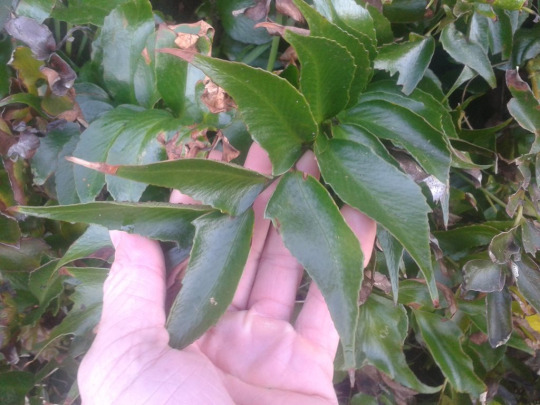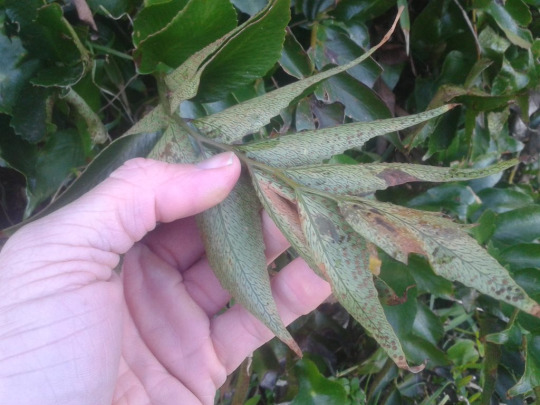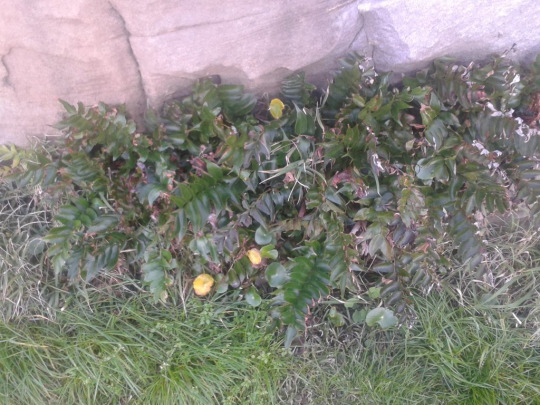#Cyrtomium falcatum
Explore tagged Tumblr posts
Text






Some unfurling action in the fern garden today 🪴
1 note
·
View note
Text
Cyrtomium falcatum: todo lo que debes saber sobre esta planta
Si te gustan los helechos, y te gustaría tener uno que fuera diferente a los que se ven en las... http://dlvr.it/SxbVd6
0 notes
Photo

Cyrtomium falcatum (at Chelsea Physic Garden) https://www.instagram.com/p/BuwAIZGlFbS/?utm_source=ig_tumblr_share&igshid=19sdu6uglbbz1
0 notes
Text
I only have 3 head vases, I don’t go out of my way to collect them, but have inherited these. After reading up on them I found they were used for floral arrangements in the 50’s and 60’s. The one on the right was my mom’s and she remembers that she received it from her mom full of flowers when one of my brothers was born in the late 50’s. Now it is even more special to me. I’ve also discovered that there is a head vase convention. Many people collect these and one lady has upwards of 3000 in her collection. Wow! (I do collect houseplants, so I get it.) In the 70’s their popularity waned and not many were made after that. I see that there is soil residue in mine so people also put houseplants in them. I have never planted anything in them. They sit on a shelf and stare off into space.
Three antique head vases
Fast forward to 2017 and new head vases are on the scene. I bought my first one at Target not too long ago and I love it. It states on the bottom it is a planter/pencil cup. If it is to be used as a planter, (which of course at my house, it is), it needs to have a hole drilled in the bottom. It is porcelain, so how it that accomplished? A diamond tipped drill bit is the best way I’ve found to drill a hole in pots without one. Masonry bits work but it is a much slower process.
Face vase from Target
A planter or pencil cup is fine but it needs a drainage hole.
A diamond tipped drill bit is a must for me
When using the diamond tipped drill bit, the container being drilled into needs to have water running on it to keep the bit and container cool. I usually drill the pot in the sink so I can run water on it while I’m drilling. I put a towel down to make sure the edges of the pot do not get damaged. This pot took a long time to drill. As you can see from the plug, it was a very thick pot. When I’m done, before planting, I add a piece of screen to keep the soil in and let the water out. If you do not want to drill a hole in any container, it can be used as a cachepot (pronounced cash-po). It is a French word which means “hide a pot”. Keep your plant in its utilitarian grower’s pot and place it in the cachepot. After watering, drain the cachepot, never allowing your plant to stand in water.
Put a towel down to protect the pot
Drilling the hole
Finished hole with plug next to it
Finished drilled hole
Screen covering hole to keep soil in and let water out
I put many different plants in the vase just to show you how different plants look in it. The “hair do” changes. If you use a tillandsia such as the xerographica in the first picture, you wouldn’t need to drill a hole. It just rests on top of the vase. I also tried a rabbit’s foot fern (Davallia fejeensis), the holly fern (Cyrtomium falcatum), a mini Boston fern (nephrolepis), and a succulent (gasteraloe). I left the gasteraloe in it.
Tillandsia xerographica as hair
Rabbit’s foot fern in face pot
Holly fern
Mini Boston fern
Gasteraloe
I bought another head vase at a market and used the rabbit’s foot fern in it. This particular one comes in a smaller size, as well. My daughter has it and there is a tillandsia in it.
Rabbit’s foot fern residing in the head vase.
The two modern head vases
Below are the 1950’s vases and the 2017 vases. What a difference, but they are both still wonderful in my opinion. Do you have any head vases? Old or new? And what do you plant in them? Please comment below!
1950’s and 2017
I thought I would throw in this last picture. I saw this yesterday on a garden walk. Head planters are out there and are ready to be planted with anything you think would make your “hair do” the best.
A head vase full of wooly thyme on a garden walk
Roots for Brains I only have 3 head vases, I don't go out of my way to collect them, but have inherited these.
#Cyrtomium falcatum#Davalia fejeensis#gasteraole#Head vases#holly fern#mini boston fern#Rabbit&039;s foot fern#Target#Tillandsia xerographica
1 note
·
View note
Photo

Cyrtomium falcatum info:https://www.edendeifiori.it/13613/cyrtomium-falcatum.php Cyrtomium falcatum: una felce sempreverde, resistente al freddo che può essere allevata in vaso e in alcune zone anche all'aperto.
#Piante da Ombra e Penombra#Piante facili da coltivare#Piante resistenti al freddo#Piante Sempreverdi#Perenni
1 note
·
View note
Photo

Happy Fern Friday!
Japanese Holly Fern (Cyrtomium falcatum). SciArt from Edward Step, Favourite Flowers of Garden and Greenhouse, Vol. 4 (1897). View more in @biodivlibrary.
40 notes
·
View notes
Text
#1410 - Cyrtomium falcatum - House Holly-fern



Also known as Japanese Holly-fern, Native to Eastern Asia, and escaped cultivation in much of Europe, North America, the Atlantic Islands, Australia, New Zealand, and South America. That’s the kind of thing that can happen when you have a hardy, frost-tolerant ornamental that can also survive as a houseplant.
In the wild it thrives in crevices in coastal cliffs, stream banks, rocky slopes, and other moist, stable areas. In this case, on my last visit back to Sydney, i found at the bottom of rocky outcrops near the shore at Bare Island.
5 notes
·
View notes
Photo


The picture on the top is my final contact print.
My Research is below:
The leftmost plant in the top row is a Dense Gayfeather (Scientific Name:Liatris spicata), which is native to Florida. This plant can grow up to 3-4 feet and resembles lavender from a distance. In the middle of the top row is a Holly Fern (Scientific Name:Cyrtomium falcatum). This plant is native to Africa and Asia, but thrives in Florida’s climate. Interestingly, this plant is resistant to deer. The rightmost plant is a Slender Gayfeather (Scientific Name:Liatris gracilis), which is native to Florida. This plant can also grow to 2-4 feet, and grows in lime rock and sandy soil. The leftmost and rightmost leaves in the bottom row are from a Southern Magnolia Tree (Scientific Name:Magnolia grandiflora). The bottom picture shows these leafs in more depth. The leftmost leaf is the smooth, firm, and dark green top of the Magnolia leaf. The rightmost leaf is the coarse, rigid, dark brown underside of the Magnolia leaf. This tree has beautiful flower blooms, can grow between 50-90 feet, and can live to 80-120 years. The white flower in the bottom row is a form of the Azalea bush called the Alabama Azalea (Scientific Name:Rhododendron alabamense), which is native to Florida. This plant is surprisingly poisonous, and can be fatal if eaten. The yellow flower next to the Azalea flower is an East Coast Sunflower (Scientific Name:Helianthus debilis), which is native to Florida. This type of sunflower is interestingly found blooming on and near the beaches on the east coast of Florida in sandy soil.
Sources:
NC State: https://plants.ces.ncsu.edu/plants/rhododendron-alabamense/#poison
USDA:https://plants.usda.gov/plantguide/pdf/pg_magr4.pdf
Florida Native Plant Society: https://www.fnps.org/plant/liatris-gracilis
Wildflower.org:https://www.wildflower.org/plants/result.php?id_plant=lisp#:~:text=Dense%20gayfeather%20or%20marsh%20blazing,)%2C%20closely%20set%20flower%20heads.
University of Florida:https://gardeningsolutions.ifas.ufl.edu/plants/ornamentals/holly-fern.html#:~:text=Holly%20fern%2C%20named%20for%20the,native%20to%20Africa%20and%20Asia.&text=It's%20such%20an%20attractive%2C%20yet,of%20the%20Year%20in%202007.
FloridaWildflowers.org: http://www.floridawildflowers.com/helianthus-debilis/
Atlas of Florida Plants: https://florida.plantatlas.usf.edu/Default.aspx
0 notes
Photo

#landscapearchitector #landscapedesigner #landscaper #ландшафтныйархитекторнаотдыхе #LeonotisLeonurus #BigBlueLilyturf (Liriope muscari) #Trumpetvine (Campsis radicans) #JapaneseNetveinHollyfern (Cyrtomium falcatum) #AraliiaJaponskaia (Fatsia japonica) #Glitziniya (Wisteria sinensis) #BlackeyedSusan (Rudbeckia hirta) #OleaEuropaea https://www.instagram.com/p/B1Mgx1BCYk_/?igshid=1lam6nnatpusf
#landscapearchitector#landscapedesigner#landscaper#ландшафтныйархитекторнаотдыхе#leonotisleonurus#bigbluelilyturf#trumpetvine#japanesenetveinhollyfern#araliiajaponskaia#glitziniya#blackeyedsusan#oleaeuropaea
0 notes
Photo

The venation on this Cyrtomium falcatum fern aka Japanese holly fern has got me like 😍🌿 #ferns #plantnerd #plantmagic #venation #cyrtomium #plantsarecool #plantstagram #plantsofinstagram #vancity
0 notes
Photo

Close up of Holly Fern (Cyrtomium Falcatum) in pot, indoors By JacquiMiller Available to license exclusively at Stocksy
0 notes